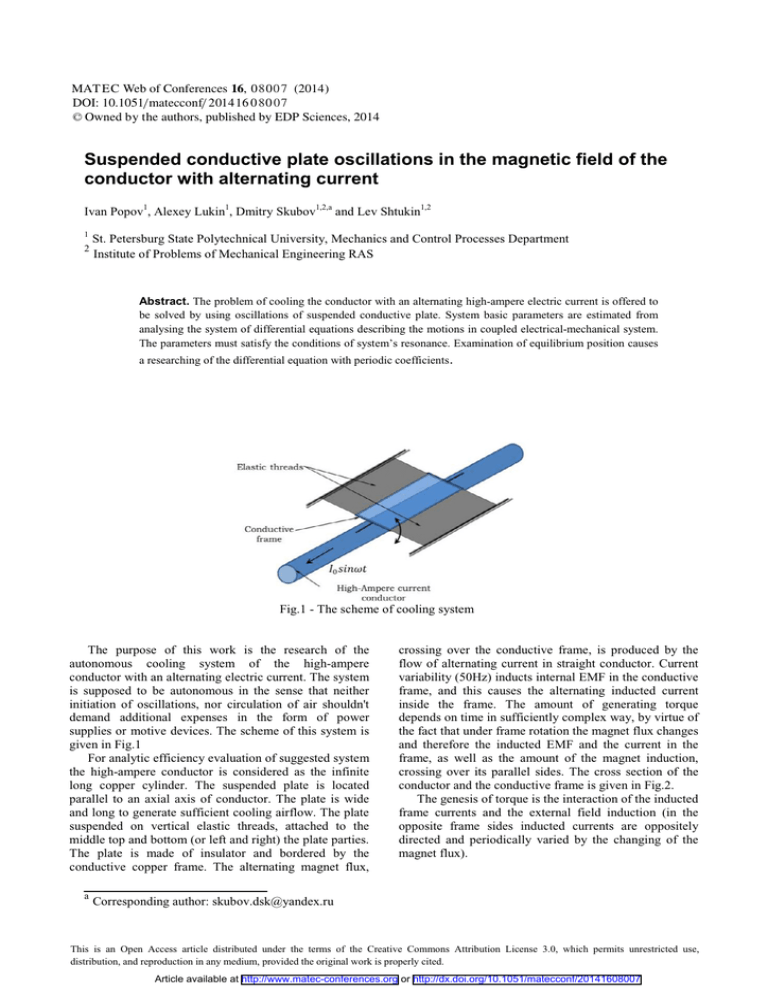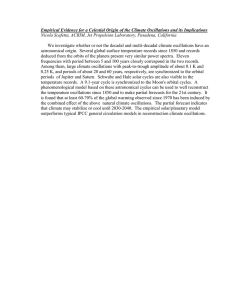, 0 0 (2014) Web of Conferences
advertisement

MAT EC Web of Conferences 16, 0 8 0 0 7 (2014)
DOI: 10.1051/matecconf/ 201 4 16 0 8 0 0 7
C Owned by the authors, published by EDP Sciences, 2014
Suspended conductive plate oscillations in the magnetic field of the
conductor with alternating current
Ivan Popov1, Alexey Lukin1, Dmitry Skubov1,2,a and Lev Shtukin1,2
1
2
St. Petersburg State Polytechnical University, Mechanics and Control Processes Department
Institute of Problems of Mechanical Engineering RAS
Abstract. The problem of cooling the conductor with an alternating high-ampere electric current is offered to
be solved by using oscillations of suspended conductive plate. System basic parameters are estimated from
analysing the system of differential equations describing the motions in coupled electrical-mechanical system.
The parameters must satisfy the conditions of system’s resonance. Examination of equilibrium position causes
a researching of the differential equation with periodic coefficients.
Fig.1 - The scheme of cooling system
The purpose of this work is the research of the
autonomous cooling system of the high-ampere
conductor with an alternating electric current. The system
is supposed to be autonomous in the sense that neither
initiation of oscillations, nor circulation of air shouldn't
demand additional expenses in the form of power
supplies or motive devices. The scheme of this system is
given in Fig.1
For analytic efficiency evaluation of suggested system
the high-ampere conductor is considered as the infinite
long copper cylinder. The suspended plate is located
parallel to an axial axis of conductor. The plate is wide
and long to generate sufficient cooling airflow. The plate
suspended on vertical elastic threads, attached to the
middle top and bottom (or left and right) the plate parties.
The plate is made of insulator and bordered by the
conductive copper frame. The alternating magnet flux,
a
crossing over the conductive frame, is produced by the
flow of alternating current in straight conductor. Current
variability (50Hz) inducts internal EMF in the conductive
frame, and this causes the alternating inducted current
inside the frame. The amount of generating torque
depends on time in sufficiently complex way, by virtue of
the fact that under frame rotation the magnet flux changes
and therefore the inducted EMF and the current in the
frame, as well as the amount of the magnet induction,
crossing over its parallel sides. The cross section of the
conductor and the conductive frame is given in Fig.2.
The genesis of torque is the interaction of the inducted
frame currents and the external field induction (in the
opposite frame sides inducted currents are oppositely
directed and periodically varied by the changing of the
magnet flux).
Corresponding author: skubov.dsk@yandex.ru
This is an Open Access article distributed under the terms of the Creative Commons Attribution License 3.0, which permits unrestricted use,
distribution, and reproduction in any medium, provided the original work is properly cited.
Article available at http://www.matec-conferences.org or http://dx.doi.org/10.1051/matecconf/20141608007
MATEC Web of Conferences
Fig.2 – Cross section of the conductor
and the conductive frame
In a rigorous formulation the magnetic flux as well as
inducted currents (and, as a result, the torque) depend not
on only directly on time but also on the rotation angle.
Therefore the mechanical and electrical current
oscillations for the frame are interrelated.
In general these oscillations should be found
coupled, as a system of two differential equations with
the following determination of the largest amplitude of
rotary oscillations, using possible variations of
parameters, including the resonant oscillations setting.
For getting the periodical process, it’s necessary to
consider the nonlinear behavior of the coupled electricalmechanical equations on account of the interaction of
electrical and mechanical processes not only linear
resonances, but also parametric resonances appear.
Satisfying parametric resonance conditions for rotary
oscillations the estimation of the parameters could be
found, instead of model of the plate with the conductive
frame, but for the case of using plane thin conductive
plate, for example, of aluminum. Let’s put mathematical
model of such a system and make the assumptions about
it to simplify analytical computations:
Current flow in cylindrical conductor
(1)
The magnetic field’s intensity of the conductor is
determined by a simple formula
(2)
Ponderomotive forces, applied on conductor’s linear unit
and inducted EMF, are described by Ampere’s and
Faraday’s laws [4]
(3)
(4)
The external magnetic field flux crossing over the frame
! " ! #$
0 %& ! #$ 12 & ! @ > A
$#
56
57
8
BC6
56
FG H
,-
A
56I
=
=
BC7
H
57
57I
D <E%$; D E%$;?
or finally
(5)
) +
(6)
(8)
(9)
<><, = > , J<, = > , , K<, > , , ;L For the frame of length inertia momentum can be
written
K
(10)
M N PH > Q R = PH > , R = P, > Q S T?
O
O
where PU ? V? – density of the frame materials (Fig.3).
Conductive part (copper or aluminum) with density PH ,
nonconductive part with density P, ? T - the frame depth,
R –section diameter of the conductive frame (axis OZ
oriented in the line of the conductor axis)
@ /
& '( ( * #.
,Substitution in (5), using the Stokes' theorem [1]
a
$# 3 4
Where 9 and : (Fig.2) are
:, ; <, = > , = <>$#;?
9, ; <, = > , <>$#;
Electromagnetic forces exert on opposite sides of
the frame:
9 9 59 ?
(7)
: : 5: ,
where 59 ? 5: - radial orts in appropriate points
The torque can be found
Integrating the (5) we use the form of the magnet
intensity by means of the magnetic potential in
cylindrical coordinate system:
%&,
)*
,-
Corresponding author: skubov.dsk@yandex.ru
08007-p.2
Fig.3 – The suspended plate parameters
CSNDD 2014
Fig. 4 - Periodic rotary oscillations of system (12)
Electromechanical processes system of differential
equations [3] in this case has the following form (11):
M;[ = \;] = E; Z
X
!
U)* +FG2^_`aFI :G I b
JFI :G I I 9cFI G I defI L
?
g = l
ij6
ij
Y
57 9 7 56
)* 2
56 iC
X hE%$ 3 4
8 = $# iC
;] k
,56 57
57 W
where E – the frame base stiffness coefficient under the
rotation, \ – coefficient of linear dissipation, g – selfinductance of the rectangular frame.
Transform system (11) to “dimensionless” form using
the parameters:
^
,FG
o
o
U
t, ? u I I ?
m n
? qr ?
v
sw
o+
#?
op
x
yw
s
2
)*
? z c-y ?
{ F :G
2)*I
,-swI
I ~
Substitution (11) to form (12)
Z
X
; || = #; | =
}I
wI
|
;
def p d ~
H9 I `UI l
qr = qr Y
, def def p d
Xz
m 3 AV =
D=
;|
H9 def H9 I `UI W
It is a system of nonlinear differential equations with
periodic coefficients. For the initial conditions
corresponding to a small and large frame deviation from
a balance position, in case of real geometrical parameters
periodic rotary oscillations have been received (Fig. 4).
Left part of Fig.4 represents the phase diagram, right part
time dependent oscillations of plate rotation angle.
If coefficients in a second equation of a system
(12), which describes change of induced current in a
frame, satisfy the natural assumption? z V, it is
permissible to neglect a first derivative of current in this
equation when receiving a stationary mode of rotation.
We get a nonlinear equation with periodic coefficients
after substitution of an explicit expression of an induced
current, which depends on m? ; and;, to the first
equation of a system (12):
a
t,
;
,
{z
u$#;
E%$m 3 NV =
S
V u$#;
(13)
u
;| !
= $#mE%$;
V u , $#, ;
uE%$;
! $#m
V u , $#, ;
The analysis of an equation (13) in assumption of
small values of a deviation angle ; was performed in
order to define the values of parameters, a frame torsional
stiffness primarily, which satisfy the conditions of frame
parametrical rotary oscillations.
The linearized equation for (13) is the following:
; || = # $#, m; | = , $#m; (? (14)
; || = #; | =
}
, .
where 5
w
Numerically evaluated Ince-Strutt diagram for the
equation (14) at different values of a dissipation
coefficient # is shown in Fig.5.
The analysis of dynamics of multiplicators on a
complex plane was performed for the equation (14) by
means of varying the parameter at a constant value of
initially, at values of ( VO? the two roots
of a characteristic polynomial for the equation (14),
which are the monodromy matrix multiplicators [2]
t, ! t = (
are located on a real axis on the different parties of
a unit circle. They quickly move towards each other, and
after a meeting they “slide” on the circle which radius
corresponds to the absolute value of a meeting position,
being thus inside a unit circle. Further, at a value of
, one of multiplicators leaves a unit circle again.
This case corresponds to the first area of instability in
Fig.5. At values of Othe roots return and slide on
the circle inside the unit one. The described process is
shown in Fig.6.
Corresponding author: skubov.dsk@yandex.ru
08007-p.3
MATEC Web of Conferences
Fig.5 – Ince-Strutt diagram
# K?
Fig.6 - Dynamics of multiplicators on a complex plane
The fact that contrary to classical Ince-Strutt diagram for
Mathieu equation with constant linear dissipation
coefficient in this instance we have smooth upper bound
for the stability domain in parameter , is an important
computational calculation result for linearized equation
(13).
The fact, that in any value of parameter # stability
domain in parameters space ? is located under the
level # corresponded to zero value of average
friction coefficient, is significant. Therefore, we obtain
the opportunity to set the system on the resonance
oscillations in a large zone of frequency , and this
guarantee the efficiency of cooling system during the
exploitation and evolution of its mechanical properties.
a
References
1.
2.
3.
4.
5.
6.
Corresponding author: skubov.dsk@yandex.ru
08007-p.4
A. P. Aksenov. Mathematics. Mathematical
analysis.vol.2 (SPbSTU, SPb, 2005) (in Russian)
I. G. Malkin. Theory of motion stability (Nauka,
Moscow, 1966) (in Russian)
U. I. Neymark, N.A. Fufaev. Dynamics of
nonholonomic systems (Nauka, Moscow, 1967) (in
Russian)
I. E. Tamm. The basis of the theory of electricity
(Nauka, Moscow, 1989) (in Russian)
Ali. H. Nayfeh. Introduction to Perturbation
Techniques (John Wiley & Sons, Inc, Canada, 1981)
Bogolyubov N. N., Mitropolsky Yu.A. Asymptotic
methods in theory of nonlinear oscillations (Nauka,
Moscow, 1974) (in Russian)
CSNDD 2014
7.
Urabe M. Galerkin method for nonlinear periodic
systems, Mechanic, 97 (1996)
08007-p.5


